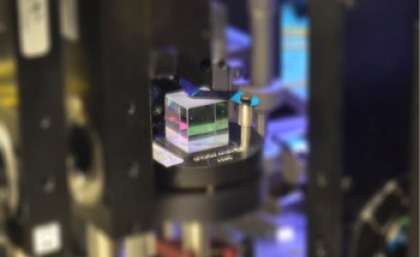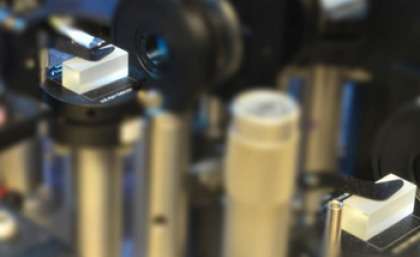Heisenberg’s uncertainty limits how sharp measurements can be performed on quantum systems. UQ researchers have now performed joint measurements of single photons, challenging the limits of quantum theory. Credit: Martin Ringbauer
(Phys.org) —A team of physicists is challenging the very limits of Heisenberg's famous uncertainty principle by measuring quantum particles with unprecedented accuracy.
Physicists from The University of Queensland have performed joint measurements on single light particles with accuracy never seen before, and developed methods that could help improve the most sensitive quantum sensors.
Martin Ringbauer, PhD student at UQ's School of Mathematics and Physics and lead author of the experimental study, said the findings help answer long-standing open questions in quantum mechanics.
"The uncertainty principle is one of the central features of quantum mechanics, which has been misunderstood for the longest time," Mr Ringbauer said.
This "Heisenberg principle" states it is impossible to jointly measure two incompatible quantities, for example speed and location, of a quantum particle with perfect accuracy.
"This experimental work settles a decade-long debate—'Heisenberg-like' relations do not hold for joint measurements," he said.
"Now that we have a complete theory, as well as experimental evidence, it is probably time to update the textbooks."
Heisenberg’s uncertainty principle does not allow the joint measurement of two quantum properties to be arbitrarily sharp. Quantum physicists from The University of Queensland have now demonstrated the optimal trade-off between the accuracy of these two measurements. Credit: Martin Ringbauer
Almost a century ago, renowned quantum theorist Werner Heisenberg found fundamental limits on how well a quantum system can be prepared and measured, known as Heisenberg's uncertainty principle.
However, only the limit that pertains to the preparation of quantum systems has been quantified; the other two, relating to measurements, have long been a matter of debate, lacking a formal treatment.
These limits are: That it is impossible to jointly measure incompatible quantities, for instance, location and speed of a quantum object, with perfect accuracy; and that a measurement of one of these quantities necessarily disturbs the other.
Last year, UQ's Cyril Branciard proposed a new set of "uncertainty relations", for the joint measurement of incompatible quantities, which describe the minimal disturbance that will occur for a given measurement accuracy.
"Branciard's relations quantify how accurately we can measure," Mr Ringbauer said.
"Testing these relations, we are now able to show in the lab that we can actually reach this ultimate limit of accuracy," he said.
The study was published in January in the journal Physical Review Letters. A related work by Kaneda et al. in the same journal, has found similar results.
More information: Experimental Joint Quantum Measurements with Minimum Uncertainty, PRL, prl.aps.org/abstract/PRL/v112/i2/e020401
Journal information: Physical Review Letters
Provided by University of Queensland






















